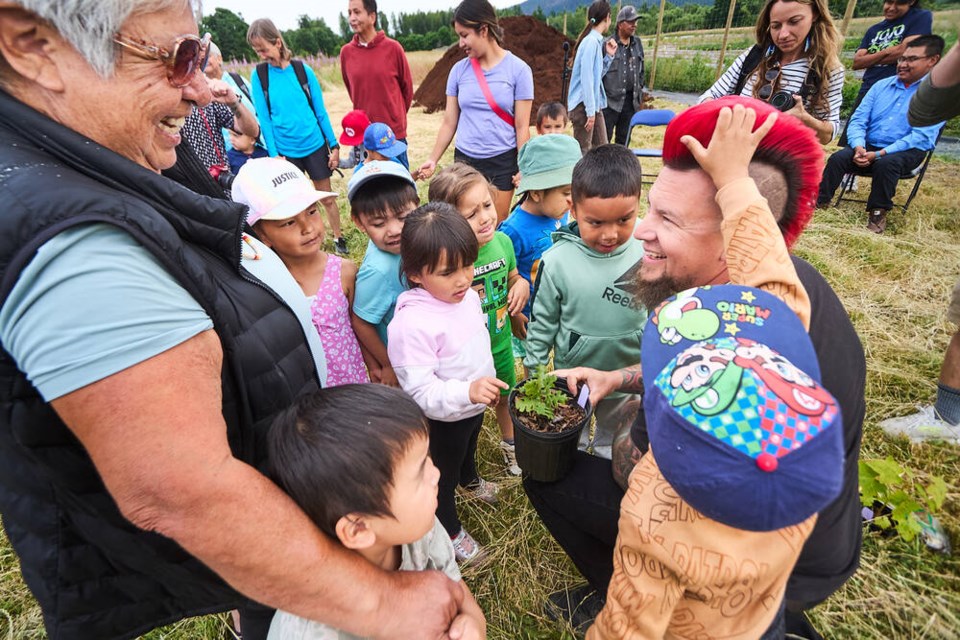Cowichan Tribes is transforming an old hay field near the Cowichan River estuary into a native-plant incubator.
The First Nation is growing 15,000 native plants in the field at the former Dinsdale Farm, with plans to use the harvest as food and medicine for its members.
On Monday, around 50 students from Quw’utsun High School and the nation’s Lelum’uy’lh Daycare Centre worked in the field with several dozen species of native plants planted last winter in a fenced-off area. Quw’utsun High’s environmental stewardship class members quickly got to work, using hori hori knives — a cross between a knife and a trowel — and other gardening equipment to weed the field.
The pre-Ks were more interested in the bright red mohawk sported by Jared Qwustenuxun Williams, who was good-naturedly teaching them the Hul’q’umi’num’ words for various native plants.
Earlier, Williams, a traditional foods chef and writer from Cowichan Tribes, said it’s a common misconception that Indigenous people historically only practised hunting and gathering.
“We’re agriculturalists as well. We specifically raised certain food plants in certain regions so we could eat. We weren’t just walking through the woods — we were helping the woods thrive so we could thrive,” he said.
Williams said growing native plants takes less water and resources than Western agricultural practices.
“If we start to eat this way, we will use less resources and we will last longer,” he said. “We used to feed everybody from the land.”
Cowichan Tribes Chief Cindy Daniels (Sulsulxumaat) said the Cowichan peoples numbered 15,000 on their territories prior to European contact, and used to trade agricultural goods such as camas for sockeye salmon with nations living along the Fraser River, before their economies were disrupted.
Daniels said another former major food source for her nation, shellfish, is no longer easily accessible to members due to the pollution of local waters.
Today, the Cowichan Tribes have a registered population of 5,600 and the vast majority of the food members eat — as for most Islanders — is produced off-Island.
Daniels said she is glad to see salmonberries, which she ate often as a child, being grown in the nursery. She remembers spending summers along the river with her friends, never needing to pack a lunch because they knew they would be able to find food on the land.
“We knew from a young age what to pick and what to eat, what to sustain ourselves [with] without having to run home for a sandwich,” she said. “I was so lucky to be born and raised that way.”
Cowichan elder Ken Elliott said it’s heartening to see the next generation take an interest in native plants.
Elliott said in the 2000s, there were still numerous three-metre-diameter circle gardens along the Cowichan River watershed, teeming with the four staple plants that families used to supplement their hunting and fishing catches: camas, chocolate lily, nodding onion and yarrow.
“The camas was our potato and the chocolate lily was our rice,” he said.
Elliott, also known as Siilh’na’mut, said his grandmother and great-grandmother taught him how to use plants for medicine, food, and tools during weekends on Penelakut Island as a child.
But they told him to forget the knowledge and to stop speaking the Hul’q’umi’num’ language when he was eight or nine so that he could fit into the public school system.
His grandmother was badly beaten as a child for practising her culture and speaking Hul’q’umi’num’, said Elliott, adding that he was the first in his family in five generations to attend public school instead of a residential school.
“My grandma had scars where the priests and the nuns would punch them and beat them,” he said. “They didn’t want us to go through what they went through.”
It took decades for Elliott, now nearing 70, to feel comfortable speaking the Hul’q’umi’num’ names of the native plants he now works to restore across the land.
“It was tucked away back there. The heart [had] locked it in because I promised grandma and I promised great-grandma that I would let it go — so even as an adult, I’m still struggling.”
For Justin Smith, a Grade 11 Quw’utsun High School student, working with native plants feels much the same as gardening in Kin Park, where he has a plot of carrots and jalapenos that he is growing for a local food bank.
But Smith, who is from the Cowichan Tribes, said he is fully on board with his nation’s initiative. “There’s an importance to replanting native plants.”
Daniels told the Times Colonist the nation has plans to double the size of the nursery in the fall so it can provide food for its people.
Some Cowichan members are living paycheque-to-paycheque and finding it difficult to make ends meet, Daniels said. “This will be a way of us being able to help all the people in the community.”



